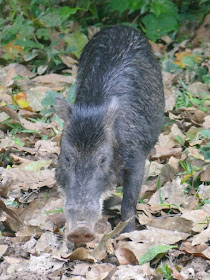This post concludes my introduction to Tambopata National Reserve and Research Centre (which includes an excellent lodge), in the southern Peruvian Amazon Basin, which began here. If you missed it, you might like to go back and read the background to the reserve - I won't bore those who did read it by repeating it here. As I promised last time, today I'm going to introduce some of the mammals and birds that we encountered on our visit there.
As a 'teaser' last time I did include a photo of part of a big herd of White-lipped Peccaries Tayassu pecari which spent some time ploughing up the ground in front of the lodge while we watched from the balcony; peccaries are notoriously stroppy animals, quite capable of seeing off a Jaguar, so that was as close as we deemed it prudent to be. Here are some more images of that memorable encounter.
 |
| White-lipped Peccaries are known as primarily fruit eaters, but this lot were definitely turning the ground over, presumably in search of tubers. |
 |
| This was a grassy 'lawn' before they worked on it! |
Monkeys formed the most diverse mammal group that we saw, with five species encountered during our stay; here are some of them.
 |
| It took us a while to realise that she had a small baby with her. |
 |
| Brown (or Tufted) Capuchin Cebus apella. (This is the traditional name for the widespread species, but it seems highly likely that several species are involved.) They have a very broad dietary range. |
Probably our most surprising mammal encounter however was with a Hoffman's Two-toed Sloth Choloepus hoffmanni on the ground, while walking at night from the canoes to our first night accommodation at Refugio Amazonas (see last posting for an explanation). They are known to come down every few days, to defecate (though no-one can explain why) or to change trees, though it should be easy enough to move from one canopy to another in many cases. Certainly they are helpless and highly vulnerable on the ground.
 |
| Hoffman's Two-toed Sloth, pulling itself along the forest floor with its powerful forefeet. |
 |
| When it felt threatened, it was prepared to defend itself with its powerful claws; not necessary on this occasion however! |
Which brings us to birds, of which there were of course very many, beginning with some very impressive vultures along the river on the trip in. After that they are pretty much randomly presented.
 |
| Large-billed Tern Phaetusa simplex, also along the river; this one is found throughout inland South America. |
 |
| Bluish-fronted Jacamar Galbula cyanescens. The jacamars comprise a family of 18 species (all in the same genus) from South and Central America, all hunters of flying insects. |
 |
| Grey-capped Flycatcher Myiozetetes granadensis, one of the vast assemblage of South American tyrant flycatchers; this one is fairly common. |
 |
| Red-necked Woodpecker Campephilus rubricollis. An impressive big woodpecker more than 30cm long, found across the rainforests and cloud forests of northern South America. |
 |
| Long-tailed Potoo Nyctibius aethereus. The potoos form a family of seven nocturnal species, masters of camouflage. |
 |
| Dwarf Tyrant-Manakin Tyranneutes stolzmanni. Most of the manakins are brilliantly coloured, but this species is more modestly attired, though small like the others. Like them too, the males form leks where they display in competition with each other to attract females. They fly rapidly from a perch at the top of a tree some 30 metres vertically upward, then hurtle down again. Such a display can of course can only be viewed from the top of the canopy, which means that not many people have done so! Although this little species occurs across northern South America, only one nest has ever been found. |
And that brings this brief introduction to Tambopata to a close. I do hope you can get there one day!
NEXT POSTING THURSDAY.
(And
remember that you can get a reminder when the next post appears by
putting your email address in the Follow by Email box in the top right
of this screen.
And I'd love to receive your comments - it's easy and you don't need to sign in!)
And I'd love to receive your comments - it's easy and you don't need to sign in!)









No comments:
Post a Comment